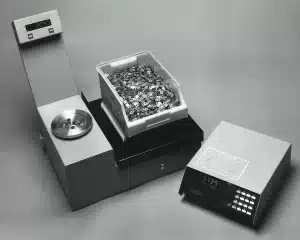About Us
Our goal has always been to enable organisations to focus on continuous improvement and to sustain their competitive advantage. The approach has become more sophisticated over the years, in keeping with scientific, technological and cultural developments, but is still guided by the underlying principles established by W. E. Deming and Walter Shewhart.
Today, we are here to share our experience and expertise, to help and guide you towards a brighter future.
Born near the start of the 3rd Industrial Revolution, we are proud to now be part of the Fourth Industrial Revolution, or Industry 4.0, helping manufacturers turn their facilities into smart factories.
Incorporation
Harford was initially established as Weighdata Limited in 1975, providing weighing equipment in the UK. We developed and manufactured our own electronic THOR balance, one of the first available on the market, which sold as far afield as Japan and Brazil.
THOR Component Counter
The very first electronic component counting/weighing device available in the UK. Compared to manual counting, the time savings and accuracy were immense!

Average Quantity Law
The Packaged Goods Regulations 1979 replaced the existing minimum weight legislation, allowing manufacturers to deal with natural process variation. This was the perfect catalyst for Weighdata to branch into software development, using the output of our digital scales.
SPC-based Weight Control
Our first software solution for Average Quantity Law compliance, utilising Statistical Process Control to minimise giveaway whilst ensuring full compliance with the law. It was an instant success, selling across Europe.

THOR Barcode Pen
Introduction of the “Light Pen” for quick and easy recording of component barcodes, linked to the THOR weighing system with printer. One of the first barcode scanners used in manufacturing environments.

Right First Time
With computerised systems deployed to factory floors, it made sense to use them for more than just weight checks. Hence, we introduced our first quality management system with instant verification, following Right First Time principles.
650 Terminal
Our first iteration of a computer-based terminal for operators on the shopfloor. Direct input from different peripherals, such as weighing scales and barcode scanners, would be analysed and reported via a connected Dot-Matrix printer.
Even after 30 years, some are still in use!

Line Efficiency
Further development took us into networked systems and the introduction of our first OEE solution. Though simplistic by today’s standards, it marked the start of our approach to fully integrate all shopfloor-related data capture, combining weight and process control with quality management and performance improvement in a single solution – without paper!
FREDA
This Food Recording Electronic Device & Analyser allowed users to weigh their meals and determined the nutrient composition automatically, helping dieticians assess, diagnose and treat dietary and nutritional problems.

Traffic Lights
Running on Windows 3.1, the very first version of our real-time reporting dashboard was launched, enabling easy access to information in real-time. A single source of truth for guiding objective decision-making.

Touchscreen Terminals
Our current approach to user interfaces utilises purpose-built stainless steel hardware, developed for aggressive production environments, capable of interfacing with a wide range of peripherals.
The user interface is deliberately easy to use, with standard guidance, visuals, and videos to guide operators through standardised processes.

Coding & Labelling
Marks & Spencer and Tesco introduce their guidelines for automated coder setup and in-line scanning, finally putting a name to what we simply considered Good Manufacturing Practice – a solution for minimising the risk of human error during line setup and packaging changes.
Harford Control Ltd.
With all of the ongoing development, our old name, Weighdata, became somewhat limiting, hence the company was officially renamed to Harford Control.
Vision Inspection
Deployment of our first in-line vision inspection system for tub & lid matching, as well as date code inspection, running at 400 packs/min.
Tablets
The mass-market introduction of tablets enabled us to add to the user experience, supplementing static touchscreen terminals with mobile units that provide bigger screens and the capability of working offline without losing data, compared to previous generations of handhelds.
Global Expansion
Having served the UK and European market for a long time, we are now supplying and supporting clients in Australia, Africa, North America and India.

Continuous Development
With a quarterly release schedule, we continuously improve our solution based on client requirements and industry developments, aiming to become a little bit better every day.
